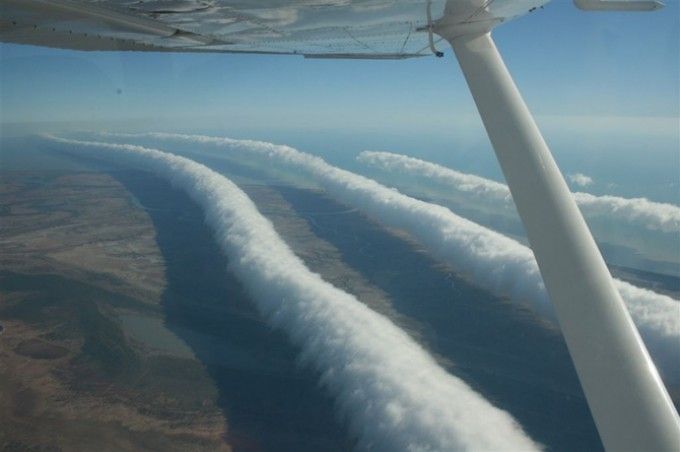Weird, Rare Clouds and the Physics Behind Them (Wired)

In August, we posted a photograph of some odd, rare clouds known as Morning Glory clouds without providing an explanation for how they form. In response to reader interest, we followed up with meteorologist Roger Smith of the University of Munich, who has studied their formation.
“Over the years we’ve developed a good understanding of them,” Smith said. “It’s no longer a mystery, but still very spectacular.”
The Morning Glory phenomenon is the result of the particular configuration of the land and sea on the Cape York Peninsula, in a remote part of Australia. The peninsula tapers off from about 350 miles wide to 60 miles as it extends north between the Gulf of Carpentaria to the west and the Coral Sea to the east. The easterly trade winds push the sea breeze across the peninsula during the daytime, which meets the sea breeze from the west coast in the late evening. The collision produces a wave disturbance moving inland to the southwest that is a key part of the cloud formation.
As moist sea air is lifted to the crest of the waves, it cools and condensation forms a cloud. Sometimes there is just one wave, but Smith has seen as many as 10 together in a series.
“If you look at the clouds, it looks as if they are rolling backwards,” Smith said. “But in fact the clouds are continuously formed at the leading edge and continuously eroded at the trailing edge. That gives a rolling appearance.”
These clouds do occur elsewhere, including Munich, where they form about once in a decade. Cape York is unique because they happen regularly in the fall above the small town of Burketown. And they can also be particularly impressive there as well, growing up to 600 miles long. Pilots fly into the area every year, hoping to see the intriguing clouds.
Not many scientists study them, or really any weird clouds, because their very rarity makes them relatively unimportant for studying precipitation or climate. So, oftentimes, their formation is poorly understood.
“It’s hard to get funding to study something that’s neat looking,” said cloud physicist Patrick Chuang of the University of California, Santa Cruz.
On the following pages, we’ve gathered photos of some of the strangest, most beautiful cloud types and asked scientists to help us understand how they form.
https://www.wired.com/2009/09/clouds/
Update october 2025: gliding in weird clouds, including the famous morning glory
